The rise of the lionhead - a rabbit detective story!
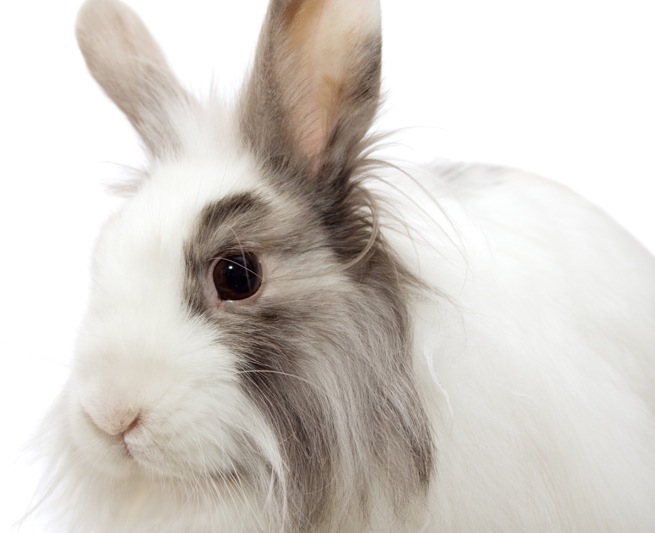
In a relatively short space of time, lionhead rabbits have become incredibly popular, but their origins are shrouded in mystery. What is clear, though, is that the first examples of this breed reached the UK from mainland Europe just 17 years ago. Today, they now almost certainly rank among the country’s most widely-kept rabbits, alongside the Dutch breed and smaller types of lop.
Things then become more confused. The ancestry of the lionhead is usually attributed to crossings involving the Swiss fox, said to be responsible for the introduction of the longhaired gene into the bloodline, and the Netherland dwarf, which accounts for the generally small size of these rabbits.
Misleading clues
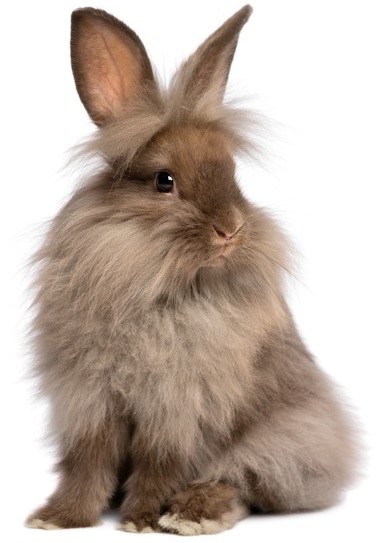
There has always been some mystery in this area though, and rather confusingly, it has even been suggested that the lionhead is descended in part from the Jersey Wooly, an American breed. This is definitely not the case though, simply because this longhaired rabbit breed had not been introduced to the show scene in the UK, or indeed, mainland Europe by the time that the lionhead first became widely known. Even today, the Jersey woolly still remains unknown in European rabbit circles.
This myth grew up simply because of the facts that the Jersey woolly emerged just beforehand, in the 1980s, and that it too has a relatively long coat. This reflects the contribution of Angora rabbits to its ancestry, although such rabbits do have such dense or long coat as a true Angora. They are also smaller in size, thanks to the input from the Netherland dwarf in their development.
But if neither of these commonly-believed stories are true, what it the truth about the lionhead, as seen left? Well, the first thing that has to be said is that these rabbits are not the result of cross breeding between two breeds, which has simply modified their coat.
Instead, their distinctive appearance is the direct result of a mutation. This has created a variable area of longer hair on the top of the head, as well as on the cheeks and, most typically, around the neck. In fact, they are named after this particular feature that has been likened to the mane of a male lion in appearance. In this case though, it is a trait displayed by both does and bucks.
The significance of this distinguishing characteristic is that it is the first true mutation that has cropped up in domestic rabbits for more than sixty years. The last time that this happened was in 1934, when the satin mutation, responsible for creating a shiny coat appearance, emerged in a litter of Havana rabbits.
First bred in Belgium?
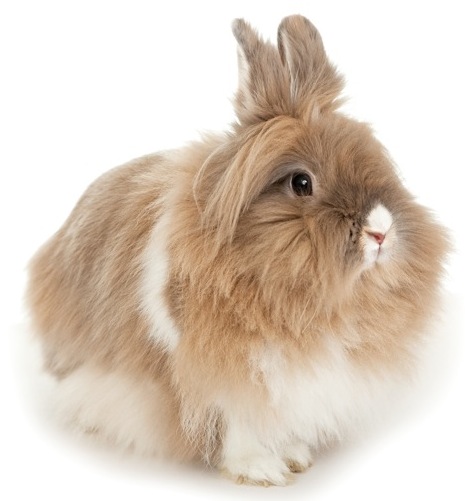
According to research carried out by the late Bob Whitman however, the true origins of the lionhead lie in Belgium, where these rabbits were originally known as the bearded rabbits of Ghent. They made their debut at a show held during 1960 in this Belgian city, being exhibited by a man called Raoul Verwulgen.
He told a strange tale, when asked about the distinctive appearance of his exhibits. Two years earlier, he had apparently been travelling through France when he unexpectedly met a man living on his own in a remote forested location.
He bred these unusual rabbits, and it was from this hermit that Vermulgen claimed to have obtained his original breeding pair as a gift. He was told that they bred true, with does never producing more than five offspring in a litter.
Dr Willem, who was working at the University of Ghent at that stage, learnt of these distinctive rabbits, and encouraged Vermulgen to exhibit them at the show, with a view to obtaining breed status for them. Unfortunately though, things did not go well on the day. People were truly intrigued by the distinctive appearance of these bearded rabbits, and wanted to know more about them.
Not everyone was convinced by Vermulgen’s story though. During a conversation with a leading Dutch judge, he became very angry, when his account of how he acquired these rabbits was subjected to close scrutiny. No-one knows exactly what was said, but Vermulgen simply took his distinctive rabbits out of their pens and disappeared, concluding his part in this story.
A subsequent Belgian link
Nothing further appears to have been documented about these rabbits either, up until the turn of the millennium. Writing in a rare breeds publication at that stage, a rabbit enthusiast called Mr Ronny de Clercq described how he first encountered bearded rabbits when visiting Zingem, which is a village located between Ghent and Oudenaarde.

Acquiring some of these unusual rabbits, De Clercq found that it was very straightforward to breed them, and they soon developed a recognisable type (appearance) and colour. Unfortunately though, their fertility suffered as a result, with their litter size falling from 10-12 kittens down to as few as three per litter.
He therefore searched out does that resembled these bearded rabbits, and used them to introduce new blood to his breeding programme. This proved to be successful, enabling him to continue developing his strain of rabbits.
De Clercq’s account raised the question as to whether Vermulgen had actually obtained his rabbits just outside Ghent, rather than from France as he had maintained? It looked as if he may not have been telling the truth.
The French connection
This was until the late Meg Brown, one of the most respected names in the Rabbit Fancy worldwide, revealed that she had first seen rabbits of similar appearance during 1966, when on a trip to France. They were of medium size, and those that Meg had been shown were of a creamy-gold shade. It was apparently not unusual for them to crop up in litters bred from ordinary rabbits, suggesting that this bearded characteristic was a genetically dominant trait.
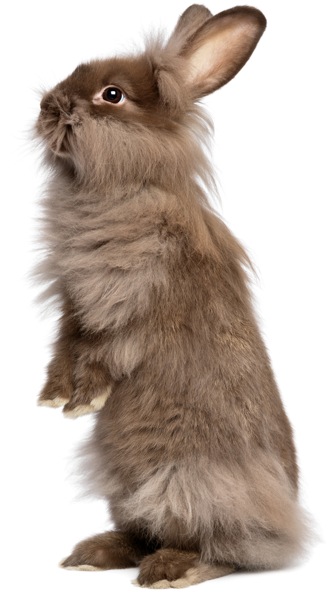
When breeders in France and Belgium were attempting to create a dwarf form of the Angora, they encountered difficulties in getting the desired woolly effect over the head and ears. They turned to the bearded rabbit for this purpose, and this cross breeding overcame the problem.
Expanding interest
During 1995, two rabbit enthusiasts called Joyce Taylor and Derek Medlock were visiting an animal show in the Belgian city of Bruges where they spotted some cute little rabbits displaying this area of longer fur on the head, which were being housed on the floor of an aviary.
They made enquiries, and finally, in association with fellow rabbit breeder Allen Fairhall, they arranged to bring a group of 21 of these distinctive rabbits from two sources back to England. Things then started to develop quickly, with the National Lionhead Rabbit Club (NLRC) being set up during the following year. The idea of a show standard was raised soon after, but not everyone was keen to see the development of what was then regarded as a longhaired rabbit, simply because of its likely grooming needs.
Early controversy
Rescue organisations especially were concerned about having another breed like the Angora, which people often take on, without appreciating the amount of work involved in keeping such rabbits, based on their grooming needs. They can then up in rescues with their coats badly matted, and this can also leave them more vulnerable to fly strike as well.
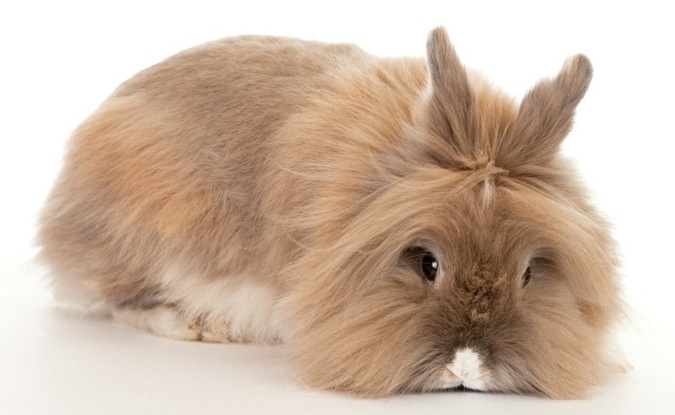
What was agreed, though, was that provided the longer fur was restricted to the area surrounding the head, and not trailing down the body, and that also, it had a silky texture which would be less inclined to mat, this could be acceptable.
There was some doubt raised as to whether this would be achievable in practice, but it has indeed proved to be possible, and now, the Lionhead has build up an international following. Exports from Belgium to the Far East, and particularly Japan, saw some of these rabbits sell for massive amounts during the mid-1990s.
The first specialty show for the NLRC followed in 2002, and it was very fitting that Joyce Taylor was awarded Best of Breed Lionhead at the event, which formed part of the Southern Championship Show that year.
Lionheads in the USA
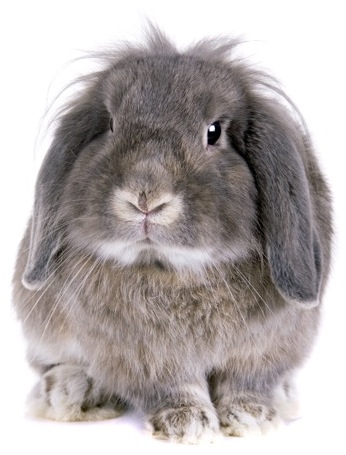
Lionheads were first imported to the USA by a breeder in the state of Minnesota, and it was here that the North American Lionhead Rabbit was subsequently founded in September 2001. The club’s show today attracts around 400 or so exhibits, entered by 50-80 breeders drawn from all over North America, reflecting the lionhead’s popularity there.
The original group of five lionheads brought from Europe proved very popular, and outcrossings with other small breeds such as the Netherland dwarf occurred early, to prevent any excessive in-breeding in the developing bloodlines. More unusually, they were also crossed with Holland lops, with a view to creating lionhead lops, as seen here.
The truth?
So was it a French hermit, or rabbit enthusiasts in a Belgian village that ultimately to the development of this breed, which now enjoys such a strong international following? Strange to say, it could be both, although the mystery will never be resolved. What we can say, though, is that the basic lionhead mutation originated in this region of Europe, where it attracted little attention for many years, until its potential was realised.
It played a key role in the development of the dwarf Angora, with the gene affecting the hair length around the head. Unfortunately though, it would appear that the French line, known as the lapin barbe (‘bearded rabbit’) as reported by Meg Brown, is now almost certainly on the verge of extinction, if it has not already disappeared.
Lionheads today
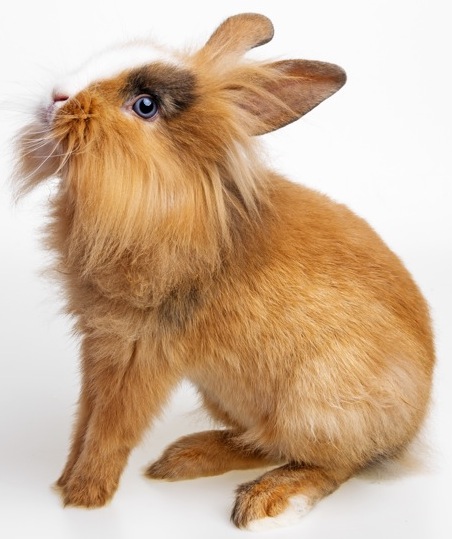
These rabbits are now being bred in a wide range of colours and patterned forms, ranging from orange to Himalayan and magpie variants. Blue-eyed individuals, as shown right, are particularly striking.
The density of the mane varies, being more profuse in the case of individuals that possess two genes rather than just a single gene for this feature. Individuals can therefore vary significantly in appearance, but there is also usually quite a difference between pet shop-type stock, and lionheads bred for exhibition purposes. Any longer areas of fur on the side of the body are described as skirts.
The mane is likely to reduce or even largely disappear in older lionheads, if they carried only a single gene for this characteristic at the outset. Cross breeding explains why there are so many varieties today. Simply mating a double gene lionhead with an ordinary rabbit without a mane will result in all the young possessing a single gene for this feature, as one has to come from each parent.
A percentage of double gene offspring can be anticipated though, if a single gene lionhead is mated with a double, although only mating two doubles together will provide the certainty that their offspring will all be the same and display the lionhead trait.
Lionheads do need slightly more grooming than ordinary short-coated rabbits, but their grooming needs are quite basic. The lionhead has proved to be a very friendly and intelligent breed, which responds well to training, ranging from learning to use a litter tray in the home to being handled by a rabbit judge.